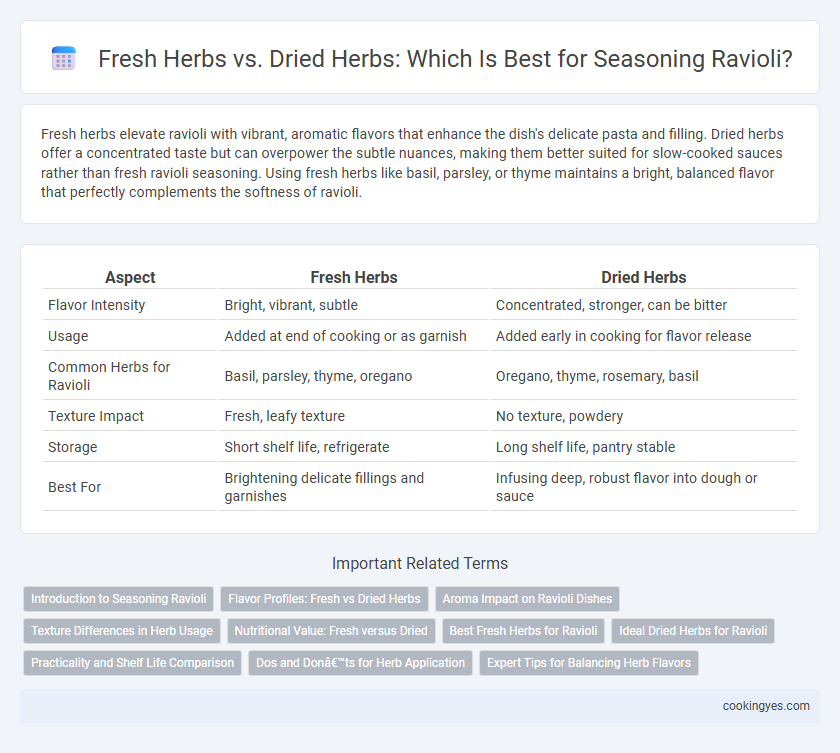Fresh herbs elevate ravioli with vibrant, aromatic flavors that enhance the dish's delicate pasta and filling. Dried herbs offer a concentrated taste but can overpower the subtle nuances, making them better suited for slow-cooked sauces rather than fresh ravioli seasoning. Using fresh herbs like basil, parsley, or thyme maintains a bright, balanced flavor that perfectly complements the softness of ravioli.
Table of Comparison
| Aspect | Fresh Herbs | Dried Herbs |
|---|---|---|
| Flavor Intensity | Bright, vibrant, subtle | Concentrated, stronger, can be bitter |
| Usage | Added at end of cooking or as garnish | Added early in cooking for flavor release |
| Common Herbs for Ravioli | Basil, parsley, thyme, oregano | Oregano, thyme, rosemary, basil |
| Texture Impact | Fresh, leafy texture | No texture, powdery |
| Storage | Short shelf life, refrigerate | Long shelf life, pantry stable |
| Best For | Brightening delicate fillings and garnishes | Infusing deep, robust flavor into dough or sauce |
Introduction to Seasoning Ravioli
Fresh herbs like basil, parsley, and thyme provide vibrant, aromatic flavors that enhance the delicate pasta and fillings in ravioli, offering a bright and fresh seasoning profile. Dried herbs, while more concentrated, should be used sparingly to avoid overpowering the subtle taste of the dish, and they often benefit from being rehydrated or cooked longer to release their full flavor. Choosing between fresh and dried herbs depends on the desired intensity and timing of seasoning, with fresh herbs typically added at the end to preserve their essence.
Flavor Profiles: Fresh vs Dried Herbs
Fresh herbs like basil, parsley, and oregano provide vibrant, bright flavors that enhance the delicate pasta and filling of ravioli, offering a fresh, aromatic bite. Dried herbs, such as dried thyme and rosemary, deliver a more concentrated, intense flavor but lack the light, crisp notes found in fresh varieties, making them better suited for longer cooking processes or infusions. Balancing fresh and dried herbs can create a complex and layered seasoning profile, intensifying the overall taste experience of ravioli dishes.
Aroma Impact on Ravioli Dishes
Fresh herbs release vibrant and intense aromas that elevate ravioli dishes by infusing delicate flavors directly into the pasta and filling. Dried herbs, while convenient, often possess a more concentrated but less fragrant profile, which can result in a muted aromatic presence when baked or boiled. The choice of fresh basil, parsley, or thyme enhances the sensory experience, making the ravioli more fragrant and appealing compared to their dried counterparts.
Texture Differences in Herb Usage
Fresh herbs in ravioli seasoning provide a vibrant, delicate texture that enhances the tender pasta without overpowering it, while dried herbs tend to offer a more concentrated, slightly coarse texture that can dominate the filling. The moisture content in fresh herbs contributes to a softer, more integrated herbaceous experience, contrasting with the crumbly, sometimes gritty presence of dried herbs. Choosing between fresh and dried herbs affects not only flavor intensity but also the mouthfeel and overall balance of seasoning in each bite of ravioli.
Nutritional Value: Fresh versus Dried
Fresh herbs used in ravioli seasoning typically retain higher levels of vitamins and antioxidants such as vitamin C and flavonoids compared to dried herbs, which can lose some nutritional value during the drying process. Dried herbs, however, offer concentrated flavors and longer shelf life, though they often contain reduced amounts of heat-sensitive nutrients. Incorporating fresh herbs like basil or parsley elevates the nutritional profile and freshness perception of ravioli dishes.
Best Fresh Herbs for Ravioli
Fresh herbs such as basil, parsley, sage, and thyme elevate the flavor profile of ravioli by adding vibrant, aromatic notes that dried herbs often lack. Basil offers a sweet and slightly peppery taste, parsley provides a fresh and mildly bitter contrast, while sage imparts a warm, earthy aroma perfect for meat or cheese-filled ravioli. Using fresh herbs enhances both the presentation and the depth of seasoning in ravioli dishes, making them more flavorful and visually appealing.
Ideal Dried Herbs for Ravioli
Ideal dried herbs for ravioli seasoning include oregano, basil, thyme, and rosemary, which deliver concentrated flavors that infuse the pasta filling and sauce. These dried herbs maintain their potency during cooking, enhancing the savory profile without overpowering the delicate texture of fresh ravioli. Using dried herbs allows for consistent seasoning and deeper herbal notes that complement cheese, tomato, and meat fillings effectively.
Practicality and Shelf Life Comparison
Fresh herbs like basil and parsley offer vibrant flavors for ravioli but have a short shelf life of about 5 to 7 days, requiring refrigeration and frequent replacement. Dried herbs such as oregano and thyme provide convenience, longer shelf stability up to several months when stored properly, and a more concentrated flavor, making them practical for seasoning ravioli over time. Balancing the intense aroma of dried herbs with the bright freshness of fresh herbs ensures optimal flavor without sacrificing shelf life or ease of use.
Dos and Don’ts for Herb Application
Use fresh herbs like basil, parsley, or thyme to enhance ravioli's delicate flavor, as they release vibrant oils that complement the pasta's texture. Avoid overpowering the dish with dried herbs by adding them sparingly early in the cooking process to mellow their intensity without masking the filling. Do finely chop fresh herbs before mixing into the filling or garnishing to ensure even distribution and maximum flavor impact.
Expert Tips for Balancing Herb Flavors
Fresh herbs like basil, parsley, and thyme provide vibrant, aromatic flavors ideal for ravioli fillings, while dried herbs offer concentrated taste that unfolds during cooking. Expert tips recommend using fresh herbs in smaller quantities to maintain brightness, layering dried herbs early in the sauce for depth, and combining both types to balance intensity without overpowering the delicate pasta. Properly balancing herb flavors enhances the overall ravioli experience, ensuring a harmonious blend that complements rather than masks the filling.
Fresh herbs vs dried herbs for ravioli seasoning Infographic

 cookingyes.com
cookingyes.com